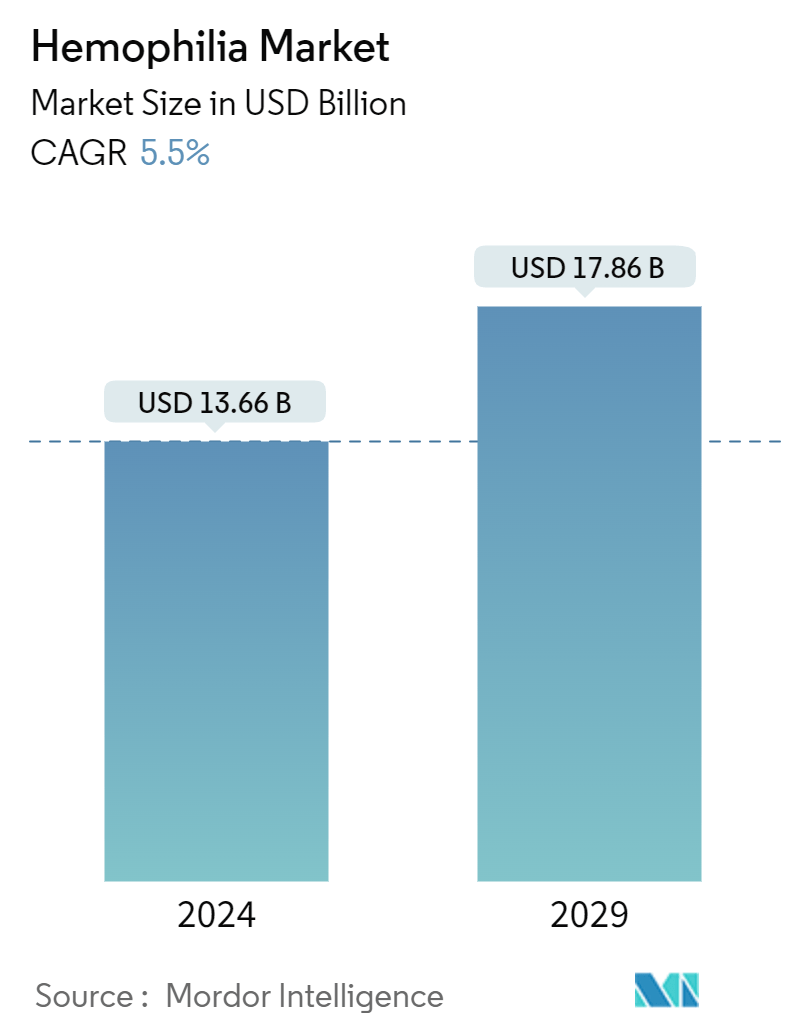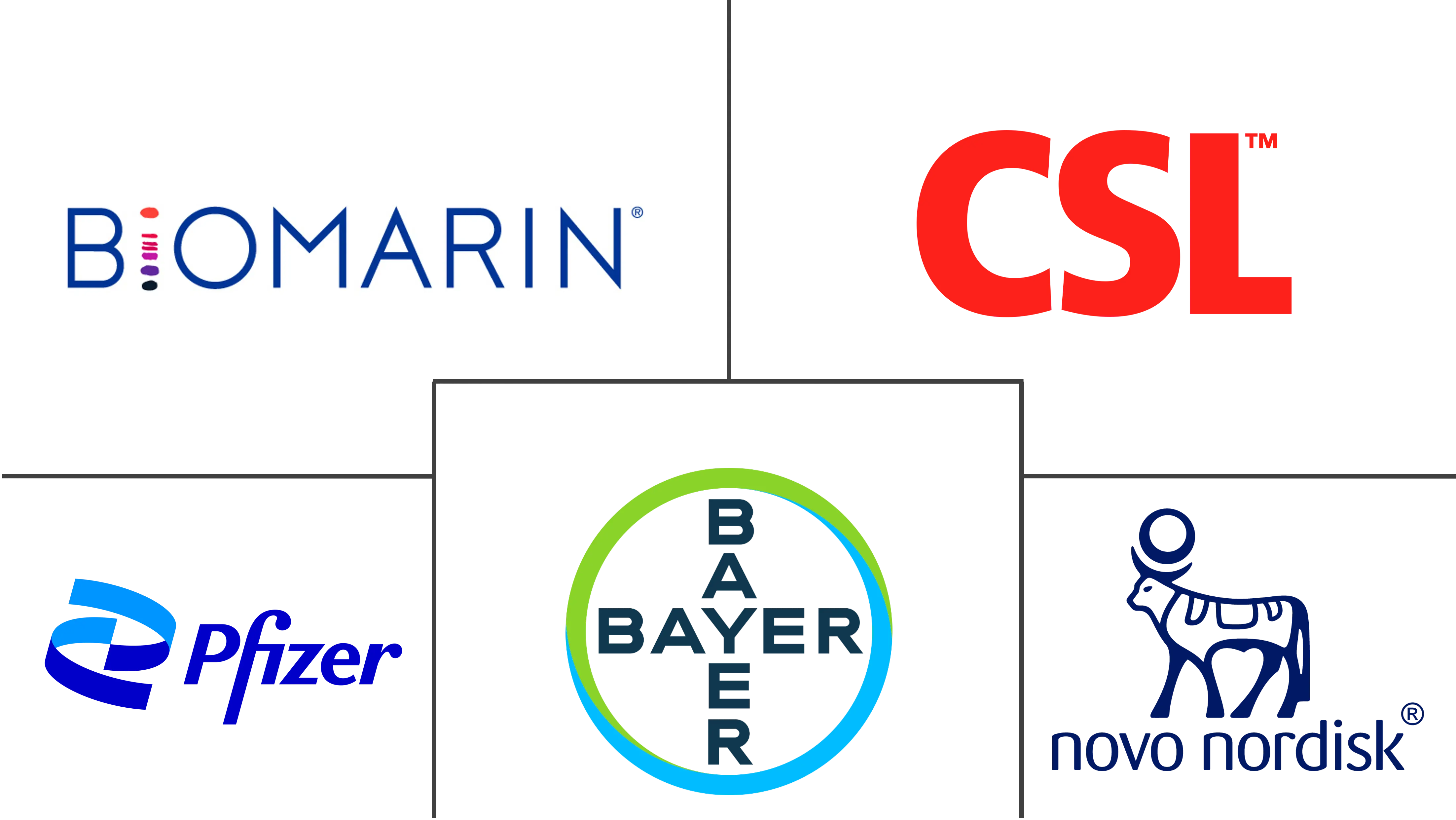
| Study Period | 2019 - 2029 |
| Market Size (2024) | USD 13.66 Billion |
| Market Size (2028) | USD 17.86 Billion |
| CAGR (2024 - 2029) | 5.50 % |
| Fastest Growing Market | Asia Pacific |
| Largest Market | North America |
| Market Concentration | Medium |
Major Players
*Disclaimer: Major Players sorted in no particular order |
Hemophilia Market Analysis
The Hemophilia Market size is estimated at USD 13.66 billion in 2024, and is expected to reach USD 17.86 billion by 2028, growing at a CAGR of 5.5% during the forecast period (2024-2028).
Certain factors driving the market’s growth include the growing prevalence of hemophilia, favorable government initiatives, and rising research and development. For instance, according to the World Federation of Hemophilia Global Report 2022, around 18,580 people were diagnosed with hemophilia in the United States in 2022. Hemophilia is a genetic blood disorder that damages the normal functionality of blood clotting and coagulation. Around 386,966 people with bleeding disorders were identified globally, of which 233,577 cases were hemophilia. Such a huge prevalence of hemophilia globally is expected to lead to increased adoption of therapies, driving market growth.
Additionally, an increase in grants for research on hemophilia is expected to contribute to market growth over the forecast period. For instance, in March 2022, a researcher from the Indiana University School of Medicine received USD 2 million from the National Heart Lung and Blood Institute to develop three major themes in a gene therapy approach that could lead to safer and potentially curative treatments for hemophilia. Such grants may lead to the development of novel therapies for hemophilia, thereby driving market growth over the forecast period.
Similarly, in January 2023, BioMarin Pharmaceutical Inc., a global biotechnology company dedicated to transforming lives through genetic discovery, publicized positive results from more than three years of follow-up from its global Phase 3 GENEr8-1 study of ROCTAVIANTM (valoctocogene roxaparvovec). It was an investigational one-time gene therapy for treating adults with severe hemophilia A. It was the largest and longest global Phase 3 study for any gene therapy in hemophilia, with 134 participants.
Moreover, rising product approvals from the US Food and Drug Administration are expected to propel market growth. For instance, in March 2022, Freeline Therapeutics Holdings PLC dosed the first patient in its Phase 1/2 B-LIEVE dose-confirmation clinical trial of FLT180a for treating hemophilia B. It is a debilitating genetic bleeding disorder caused by a clotting factor IX protein deficiency.
Thus, due to the rise in hemophilia cases and the increase in product launches, coupled with research and development for hemophilia therapies, the market studied is expected to witness significant growth during the forecast period. However, the high cost of hemophilia treatment and the need for more awareness among people regarding advanced technologies are expected to hinder market growth.
Hemophilia Industry Segmentation
As per the scope of the report, hemophilia is a genetic bleeding disorder that prevents the blood from clotting normally due to a lack of enough blood-clotting proteins (clotting factors). People with hemophilia contain low levels of either factor VIII (8) or factor IX (9). The primary symptom is uncontrolled, often spontaneous bleeding in different body areas. The amount of bleeding depends on the severity of hemophilia.
The hemophilia market is segmented by disease type, therapy, product type, and geography. By disease type, the market is segmented as hemophilia A, hemophilia B, and other disease types. By therapy, the market is segmented as replacement therapy, gene therapy, and other therapies. By product type, the market is segmented as recombinant coagulation factor concentrates, plasma-derived coagulation factor concentrates, and other product types. By geography, the market is segmented as North America, Europe, Asia-Pacific, Middle East and Africa, and South America. The report also covers the estimated market sizes and trends for 17 countries across major regions globally and offers the value (USD) for the above segments.
| Hemophilia A |
| Hemophilia B |
| Other Disease Types |
| Replacement Therapy |
| Gene Therapy |
| Other Therapies |
| Recombinant Coagulation Factor Concentrates |
| Plasma-derived Coagulation Factor Concentrates |
| Other Product Types |
| North America | United States |
| Canada | |
| Mexico | |
| Europe | Germany |
| United Kingdom | |
| France | |
| Italy | |
| Spain | |
| Rest of Europe | |
| Asia-Pacific | China |
| Japan | |
| India | |
| Australia | |
| South Korea | |
| Rest of Asia-Pacific | |
| Middle East and Africa | GCC |
| South Africa | |
| Rest of Middle East and Africa | |
| South America | Brazil |
| Argentina | |
| Rest of South America |
Hemophilia Market Size Summary
The hemophilia market is poised for significant growth, driven by an increasing prevalence of the disorder and advancements in treatment therapies. The market is experiencing a resurgence following the challenges posed by the COVID-19 pandemic, which had previously hindered growth due to increased health risks and logistical challenges for patients. The availability of advanced therapies and favorable government initiatives are contributing to the market's expansion. Research and development efforts, including substantial grants for gene therapy advancements, are expected to further propel the market. The introduction of novel therapies and product approvals, particularly in the United States, is anticipated to enhance treatment options and drive market dynamics.
Hemophilia A, the most common severe bleeding disorder, is expected to hold a significant market share due to its high prevalence and the development of various therapies. The market is characterized by moderate competition, with key players engaging in strategic alliances and product launches to strengthen their market position. North America is projected to maintain a substantial market share, supported by increasing awareness, favorable regional policies, and ongoing research initiatives. The market's growth trajectory is also bolstered by regulatory approvals and the introduction of innovative treatments, which are expected to address the needs of patients and enhance therapeutic outcomes.
Hemophilia Market Size - Table of Contents
1. MARKET DYNAMICS
- 1.1 Market Overview
-
1.2 Market Drivers
- 1.2.1 Growing Prevalence of Hemophilia
- 1.2.2 Favorable Government Initiatives
- 1.2.3 Rising R&D and New Product Development
-
1.3 Market Restraints
- 1.3.1 High Cost of Treatment
- 1.3.2 Lack of Awareness Regarding Advanced Technologies
-
1.4 Porter's Five Forces Analysis
- 1.4.1 Bargaining Power of Suppliers
- 1.4.2 Bargaining Power of Buyers/Consumers
- 1.4.3 Threat of New Entrants
- 1.4.4 Threat of Substitute Products
- 1.4.5 Intensity of Competitive Rivalry
2. MARKET SEGMENTATION (Market Size by Value - USD)
-
2.1 By Disease Type
- 2.1.1 Hemophilia A
- 2.1.2 Hemophilia B
- 2.1.3 Other Disease Types
-
2.2 By Therapy
- 2.2.1 Replacement Therapy
- 2.2.2 Gene Therapy
- 2.2.3 Other Therapies
-
2.3 By Product Type
- 2.3.1 Recombinant Coagulation Factor Concentrates
- 2.3.2 Plasma-derived Coagulation Factor Concentrates
- 2.3.3 Other Product Types
-
2.4 By Geography
- 2.4.1 North America
- 2.4.1.1 United States
- 2.4.1.2 Canada
- 2.4.1.3 Mexico
- 2.4.2 Europe
- 2.4.2.1 Germany
- 2.4.2.2 United Kingdom
- 2.4.2.3 France
- 2.4.2.4 Italy
- 2.4.2.5 Spain
- 2.4.2.6 Rest of Europe
- 2.4.3 Asia-Pacific
- 2.4.3.1 China
- 2.4.3.2 Japan
- 2.4.3.3 India
- 2.4.3.4 Australia
- 2.4.3.5 South Korea
- 2.4.3.6 Rest of Asia-Pacific
- 2.4.4 Middle East and Africa
- 2.4.4.1 GCC
- 2.4.4.2 South Africa
- 2.4.4.3 Rest of Middle East and Africa
- 2.4.5 South America
- 2.4.5.1 Brazil
- 2.4.5.2 Argentina
- 2.4.5.3 Rest of South America
Hemophilia Market Research FAQs
How big is the Hemophilia Market?
The Hemophilia Market size is expected to reach USD 14.41 billion in 2025 and grow at a CAGR of 5.5% to reach USD 18.83 billion by 2030.
What is the current Hemophilia Market size?
In 2025, the Hemophilia Market size is expected to reach USD 14.41 billion.


